
The products shown in this guide are only intended to serve as examples to illustrate the accessibility guidelines, and are not intended as endorsements of the products. Other products may be available. The Access Board does not evaluate or certify products for compliance with the accessibility guidelines. Users are advised to obtain and review product specifications for compliance with the accessibility guidelines.
Introduction
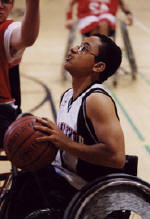
The Americans with Disabilities Act (ADA) is a comprehensive civil rights law that prohibits discrimination on the basis of disability. The ADA requires that newly constructed and altered state and local government facilities, places of public accommodation, and commercial facilities be readily accessible to, and usable by, individuals with disabilities. The ADA Accessibility Guidelines (ADAAG) is the standard applied to buildings and facilities. Recreational facilities, including sports facilities, are among the facilities required to comply with the ADA.
The Access Board issued accessibility guidelines for newly constructed and altered recreation facilities in 2002. The recreation facility guidelines are a supplement to ADAAG. As a supplement, they must be used in conjunction with ADAAG. References to ADAAG are mentioned throughout this summary. Once these guidelines are adopted by the Department of Justice (DOJ), all newly designed, constructed and altered recreation facilities covered by the ADA will be required to comply.
The recreation facility guidelines cover the following facilities and elements:
- Amusement rides
- Boating facilities
- Fishing piers and platforms
- Miniature golf courses
- Golf courses
- Exercise equipment
- Bowling lanes
- Shooting facilities
- Swimming pools, wading pools, and spas
This guide is intended to help designers and operators in using the accessibility guidelines for sports facilities. These guidelines establish minimum accessibility requirements for newly designed or newly constructed and altered sports facilities. This guide is not a collection of sports facility designs. Rather, it provides specifications for elements within a sports facility to create a general level of usability for individuals with disabilities. Emphasis is placed on ensuring that individuals with disabilities are generally able to access the sports facility and use a variety of elements. Designers and operators are encouraged to exceed the guidelines where possible to provide increased accessibility and opportunities. Incorporating accessibility into the design of a sports facility should begin early in the planning process with careful consideration of accessible routes.
The recreation facility guidelines were developed with significant public participation. In 1993, the Access Board established an advisory committee of 27 members to recommend accessibility guidelines for recreation facilities. The Recreation Access Advisory Committee represented the following groups and associations:
- American Ski Federation
- American Society for Testing and Materials (Public Playground Safety Committee)
- American Society of Landscape Architects
- Beneficial Designs
- City and County of San Francisco, California, Department of Public Works
- Disabled American Veterans
- Environmental Access
- Golf Course Superintendents Association of America
- Hawaii Disability and Communication Access Board
- International Association of Amusement Parks and Attractions
- Katherine McGuinness and Associates
- Lehman, Smith, and Wiseman Associates
- Michigan Department of Natural Resources
- National Council on Independent Living
- National Park Service
- National Recreation and Park Association
- New Jersey Department of Community Affairs
- Outdoor Amusement Business Association
- Paralyzed Veterans of America
- Professional Golfer’s Association
- Self Help for Hard of Hearing People
- States Organization for Boating Access
- Universal Studios
- U.S. Army Corps of Engineers
- U.S. Forest Service
- Y.M.C.A. of the U.S.A.
- Walt Disney Imagineering
The public was given an opportunity to comment on the recommended accessibility guidelines, and the Access Board made changes to the recommended guidelines based on the public comments. A notice of proposed rulemaking (NPRM) was published in the Federal Register in July 1999, followed by a five-month public comment period. Further input from the public was sought in July 2000 when the Access Board published a draft final rule soliciting comment. A final rule was published in September 2002.
Accessible Sports Facilities
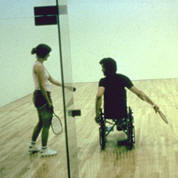 Whenever any barrier stands between you and the full rights and dignity of citizenship, we must work to remove it, in the name of simple decency and justice. The promise of the ADA…has enabled people with disabilities to enjoy much greater access to a wide range of affordable travel, recreational opportunities and life-enriching services.”
Whenever any barrier stands between you and the full rights and dignity of citizenship, we must work to remove it, in the name of simple decency and justice. The promise of the ADA…has enabled people with disabilities to enjoy much greater access to a wide range of affordable travel, recreational opportunities and life-enriching services.”
President George W. Bush, New Freedom Initiative, February 1, 2001
The recreation facility guidelines described in this guide focus on the accessible features of unique sports-related elements in newly designed or newly constructed and altered facilities. Other provisions contained in ADAAG address elements commonly found within a sports facility, such as accessible vehicle parking spaces, exterior accessible routes, doors, assembly sections, and toilet and bathing facilities. ADAAG addresses only the built environment (structures and grounds). The guidelines do not address operational issues. Questions regarding operational issues should be directed to the Department of Justice, 1-800-514-0301 or 1-800-514-0383 (TTY).
Facilities and elements covered include:
- Areas of indoor and outdoor sports activity, including court sports (such as tennis, volleyball and racquetball), sports fields (such as softball, football, lacrosse, baseball, and soccer) and other sports (such as gymnastics and wrestling)
- Dressing, fitting, and locker rooms
- Team or player seating areas
- Exercise equipment and machines
- Saunas and steam rooms
- Animal containment areas for public use such as petting zoos and passageways along animal pens at fairs
- Bowling lanes
- Shooting facilities
These recreation facility guidelines do not apply to:
- Raised structures used for refereeing, judging, or scoring a sport
- Animal containment areas not for public use
- Raised boxing rings and wrestling rings
- Water slides (as long as an accessible route is provided to the base)
Accessible Routes
Accessible routes are continuous, unobstructed paths connecting all accessible elements and spaces of a building or facility. The accessible route must comply with ADAAG provisions for the location, width (minimum of 36 inches), passing space, head room, surface, slope (maximum of 1:12 or 8.33%), changes in level, doors, egress, and areas of rescue assistance, unless otherwise modified by specific provisions outlined in this guide. Facilities must provide accessible routes connecting all accessible elements and spaces within areas of indoor or outdoor sports activities. If not all elements need to be accessible, only those that are accessible must be connected with an accessible route. The guidelines apply to “fixed” facilities and elements. They do not cover equipment that is frequently moved. For example, a wrestling mat or badminton net may be portable and moved regularly.
Court Sports

Where courts are provided, an accessible route must connect each court. Accessible routes must comply with all ADAAG requirements, such as width and changes in level or surface, and must directly connect both sides of the court. Players must not be required to traverse through another court to get to the other side of their court. This is especially critical in sports like tennis, in which changing sides of the court is part of the game. No additional accessibility guidelines apply once on the court.
Areas of Sport Activities
An “area of sport activity” is a broad term intended to cover a diverse number of indoor and outdoor sports fields and areas. This includes, but is not limited to: basketball courts, baseball fields, running tracks, soccer fields, and skating rinks. The “area of sport activity” is “that portion of a room or space where the play or practice of a sport occurs.” For example, football fields are defined by boundary lines. In addition, a safety border is provided around the field. Players may temporarily be in the space between the boundary lines and the safety border when they are pushed out of bounds or momentum carries them forward when receiving a pass. So in football, that space is used as part of the game and is included in the area of sport activity.
Accessible routes must connect each area of sport activity. Areas of sport activities must comply with all ADAAG requirements, except that they are exempt from the requirement that surfaces must be stable, firm, and slip resistant, and from the restrictions on carpets, grating, and changes in level. They are also exempt from restrictions on protruding objects. These provisions are not required inside of the area of sport activity since they may affect the fundamental nature of the sport or activity. For example, an accessible route is required to connect to the boundary of a soccer field, but there is no requirement to change the surface of a field to an accessible surface.
Where light fixtures or gates are provided as part of a court sport or other area of sport activity, they must comply with ADAAG provisions for controls and operating mechanisms, and for gates and doors.

Animal Containment Areas
If the public has access to an animal containment area, accessible routes must connect to each animal containment area. Examples may include petting zoos, petting farms, public pathways for viewing livestock display tents, or other areas where the public has access to animals. These areas must comply with all ADAAG requirements, except the requirements that surfaces be stable, firm, and slip resistant and the restrictions on changes in level since some surfaces need to be absorbent. Accessibility is not required in areas that are for animal handlers and not for public use.
Dressing, Fitting, or Locker Rooms
When provided, dressing, fitting, or locker rooms must be accessible and comply with all ADAAG provisions. If they are in a cluster, 5 percent, or at least one must be accessible. There must be an accessible route through the door and to all elements required to be accessible in the room. Operating mechanisms provided on accessible lockers must also meet ADAAG provisions for their operation and height.
Lockers
If lockers are provided, at least 5 percent, but not less than one of each type (full, half, quarter, etc.) must be accessible. Accessible benches should be located adjacent to the accessible lockers.
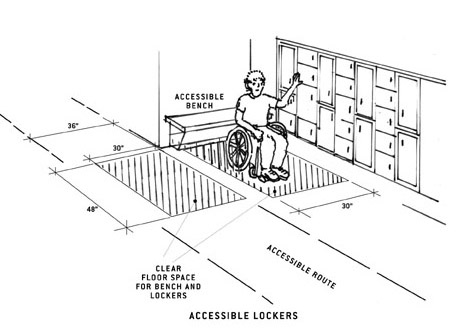
Benches
Accessible benches are required in dressing, fitting, and locker rooms, and where seating is provided in saunas and steam rooms. Benches must have a clear floor space positioned to allow persons using wheelchairs or other mobility devices to approach parallel to the short end of a bench seat. In saunas and steam rooms, this floor space may be obstructed by readily removable seats.
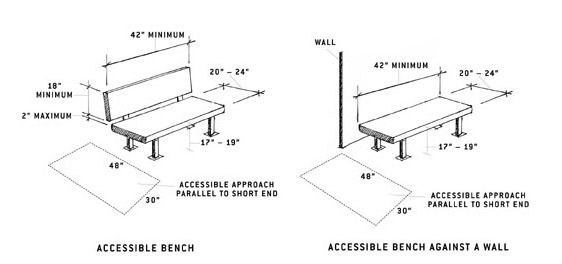
Benches must have seats that are a minimum of 20 inches to a maximum of 24 inches in depth and 42 inches minimum in length. The seat height should be a minimum of 17 inches to a maximum of 19 inches above the finished floor. If the bench is not located next to a wall, the bench must have back support that is 42 inches minimum in length and extends from a point 2 inches maximum above the seat to a point 18 inches minimum above the bench. Benches must be strong enough to withstand a vertical or horizontal force of 250 pounds applied at any point on the seat, fastener, mounting device, or supporting structure. The provisions for benches are not intended to apply to park benches or other benches used for sitting or resting.
If benches are located in wet areas, the surface must be slip-resistant and designed not to accumulate water.
Team Player Seating Areas
Where provided, fixed team or player seating areas must contain the number of wheelchair spaces and companion seats required by ADAAG (based on the number of seats provided), but not less than one space. One option is to provide a clear space adjacent to a fixed bench, with the bench serving as companion seating. If designers and operators are designing a field or court that will serve a variety of wheelchair sports, exceeding the minimum requirements will better accommodate participants.
Wheelchair spaces in the team player seating areas are exempt from the requirements related to admission price and line of sight choices in assembly areas. It is recommended that ramps be used wherever possible for accessible routes connecting team or player seating areas and areas of sport activity. However, a platform lift may be used as part of an accessible route to team player seating areas.
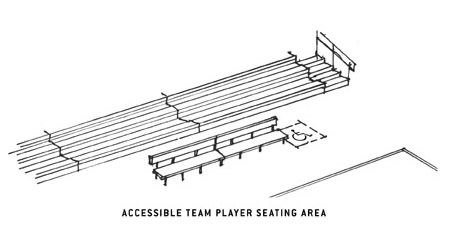
Saunas and Steam Rooms
If saunas or steam rooms are in a cluster, at least 5 percent, but not less than one of each type must be accessible. The wheelchair turning space in the sauna or steam room must comply with ADAAG, except that it can be obstructed by readily removable seats. If seating is provided, at least one bench must be accessible. Doors cannot swing into any part of the clear floor or ground space required for benches.
Exercise Equipment and Machines
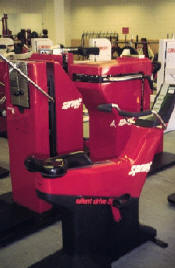
At least one of each type of exercise equipment or machine must have clear floor space of at least 30 by 48 inches and be served by an accessible route. If the clear space is enclosed on three sides (e.g., by walls or the equipment itself), the clear space must be at least 36 by 48 inches.
Most strength training equipment and machines would be considered different types. For example, a bench press machine is different from a biceps curl machine. If operators provide both a biceps curl machine and free weights, both must meet the guidelines in this section even though both can be used to strengthen biceps. Likewise, cardiovascular exercise machines, such as stationary bicycles, rowing machines, stair climbers and treadmills, are all different types of machines. But if the only difference in equipment provided is that they have different manufacturers, but are the same type, only one must comply.
Clear floor space must be positioned to allow a person to transfer from a wheelchair or to use the equipment while seated in a wheelchair. For example, to make a shoulder press accessible, the clear floor space should be next to the seat. But the clear floor space for a bench press designed for use by a person using a wheelchair would be centered on the operating mechanisms. Clear floor space for more than one piece of equipment may overlap. For example, where different types of exercise equipment and machines are located next to other pieces of equipment, the clear space may be shared. (See figure “Clear Space Requirements Around Exercise Equipment” on page 12.)
The exercise equipment and machines themselves do not need to comply with the ADAAG requirements regarding controls and operating mechanisms.
Designers and operators are encouraged to select exercise equipment that provides fitness opportunities for persons with lower body extremity disabilities.

Shooting Facilities
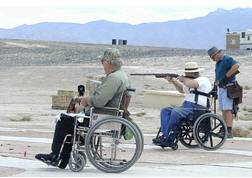
If facilities provide fixed firing positions, at least 5 percent, but not less than one of each type of fixed firing position must be served by an accessible route. Fixed firing positions must have a 60-inch diameter space with slopes not steeper than 1:48 so a wheelchair user can turn around and have a level place from which to shoot.
Types of different firing positions include positions with different admission prices, positions with or without weather covering or lighting, and positions that support different shooting events (e.g., muzzle loading rifle, small bore rifle, high power rifle, bull’s eye pistol, action pistol, silhouette, trap, skeet, and archery).
Bowling Lanes
At least 5 percent, but not less than one, of each type of bowling lane must be accessible. Unlike other areas of sport activity, only those team or player seating areas that serve accessible lanes must be connected with an accessible route and comply with seating requirements. Spectator seating in bowling facilities is addressed in ADAAG and will require wheelchair spaces, companion seating, and designated aisle seats.

Provision Index
This table highlights the sections of the ADA and ABA Accessibility Standards discussed in the sports facilities guide.
* The guide uses the term ADAAG (Americans with Disabilities Act Accessibility Guidelines) as the basis of the requirements discussed. The recreational provisions of these guidelines were adopted into the 2010 ADA Standards without changes, so the ADAAG section numbers correspond to the same section numbers in the ADA Standards (as well as the Architectural Barriers Act (ABA) Accessibility Standards).
| ADA Standards* | ABA Standards | |
|---|---|---|
| Definitions | 106.5 | F106.5 |
| Area of Sport Activity | 106.5 | F106.5 |
| Cross Slope | 106.5 | F106.5 |
| Curb Ramp | 106.5 | F106.5 |
| Facility | 106.5 | F106.5 |
| Ground Level Play Component | 106.5 | F106.5 |
| Ramp | 106.5 | F106.5 |
| Running Slope | 106.5 | F106.5 |
| ADA Standards* | ABA Standards | |
|---|---|---|
| Dressing, Fitting, and Locker Rooms | 222 | F222 |
| Exercise Machines and Equipment | 236 | F236 |
| Lockers | 225.2.1 | F225.2.1 |
| Sauna and Steam Rooms | 241 | F241 |
| Shooting Facilities with Firing Positions | 243 | F243 |
| Spectator Seating | 221 | F221 |
| Team/Player Seating Areas | 221.2.1.4 | F221.2.1.4 |
| ADA Standards* | ABA Standards | |
|---|---|---|
| Accessible Routes (where required) | 206 | F206 |
| Animal Containment Areas | 201 | F201 |
| Area of Sports Activity | 201 | F201 |
| Bowling Lanes (specific provision) | 206.2.11 | F206.2.10 |
| Court Sports (specific provision) | 206.2.12 | F206.2.11 |
| Exercise Machines and Equipment (specific provision) | 206.2.13 | F206.2.12 |
| Platform Lift 206.2.11 (new construction use) | 206.7.9 | F206.7.9 |
| ADA Standards* | ABA Standards | |
|---|---|---|
| Curb Ramps | 406 | 406 |
| Doors and Gates | 404 | 404 |
| Ramps | 405 | 405 |
| Walking Surfaces with Running Slopes of 5% or less | 403 | 403 |
| ADA Standards* | ABA Standards | |
|---|---|---|
| Benches (for dressing) | 803.4 & 903 | 803.4 & 903 |
| Dressing, Fitting, and Locker Rooms | 803 | 803 |
| Exercise Machines and Equipment | 1004 | 1004 |
| Sauna and Steam Rooms | 612 | 612 |
| Shooting Facilities with Firing Positions | 1010 | 1010 |
| ADA Standards* | ABA Standards | |
|---|---|---|
| Dining surfaces | 226 | F226 |
| Drinking Fountains | 211 | F211 |
| Parking | 208 | F208 |
| Passenger Loading Zones and Bus Stops | 209 | F209 |
| Press Boxes | 206.2.7 | F206.2.7 |
| Service Counters | 227.3 | F227.3 |
| Signage | 216 | F216 |
| Toilet and Bathing | 213 | F213 |
| Vending Machines | 228 | F228 |
| ADA Standards* | ABA Standards | |
|---|---|---|
| Animal Containment Area (non-public) | 203.12 | F203.12 |
| Animal Containment Area (floor and ground surfaces) | 302.1 EX 1 | 302.1 EX 1 |
| Animal Containment Area (change in level) | 303.1 EX 1 | 303.1 EX 1 |
| Area of Sports Activity (floor and ground surfaces) | 302.1 EX 2 | 302.1 EX 2 |
| Area of Sports Activity (changes in level) | 303.1 EX 2 | 303.1 EX 2 |
| Area of Sports Activity (protruding objects) | 204 EX 1 | F204 EX 1 |
| Employee Work Areas | 203.9 | no similar exception |
| Exercise Machines and Equipment (operable parts) | 205.1 EX 8 | F205.1 EX 8 |
| Press Box (in bleachers or free standing) | 206.2.7 EX 1 & 2 | F206.2.7 EX 1 & 2 |
| Raised Refereeing, Judging, and Scoring Areas | 203.10 | F203.10 |
| Raised Boxing or Wrestling Rings | 203.13 | F203.13 |
| Team/Player Seating Areas (at bowling lanes) | 221.2.1.4 EX | F221.2.1.4 EX |
| Team/Player Seating Areas (lines of sight, etc.) | 221.2.3 EX | F221.2.3 EX |




